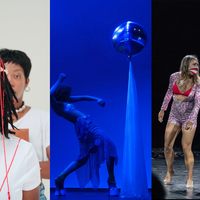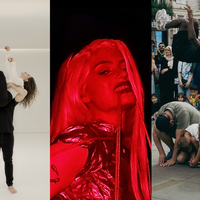Wed 15 Jan: Blue Pieta, Sarah Santos and Mathangi Keshavan

News Story
The standout work of the night was undoubtedly Sarah Santos’ solo Stranded, a profoundly moving exploration of Black women reclaiming the beauty of their natural hair and physical features. It opens with a projection of a sunrise, something resembling seaweed swaying with hypnotic grace at the centre of the stage. Is it one dancer, or many? Something scary, or a mermaid? Then Santos appears. Her movements shift between controlled, intentional falls—sometimes striking the floor hard, sometimes softened by Vivian Kiill’s stunning hair sculpture, as if cushioned by ancestors. While remaining deeply rooted in colonial history, Santos’ piece transcended cultural specificity. Strong rhythmic full-body motions emphasise pain, resilience and joy, offering a profound exploration of feminine energy. Collaborating with South African composer Thabo Letseleha Naha, the evocative soundscape paired with Santos’ spoken word elevated Stranded into a sensory and emotional masterpiece.
Mother Heart by Blue Pieta blended poetry, opera, dance, and visual art into an ambitious multidisciplinary work. Kath Gifford’s stunning live singing and Benjin’s melodic guitar accompaniment is captivating. However, Pieta’s abundance of layered elements, including narration, animal motifs, nudity, and colour’s theme occasionally overshadows the choreography. While Blue Pieta showcased many interesting ideas, a tighter focus might have enhanced its overall impact.
Mathangi Keshavan’s0’s and 1’s presents a brilliant fusion of Bharatanatyam and modern technology, exploring the evolution of communication. Keshavan skillfully blends classical Indian dance with contemporary themes, accompanied by veena and percussion music that add depth and tradition. The vibrant stage lighting enhances the precise synchronised dancers’ footwork and emotive facial expressions. While some scene transitions feel abrupt, the interplay of classical dance and innovation is captivating. Overall, it’s a fantastic idea, showcasing Keshavan’s artistry and London’s rich multicultural essence.
While each work offered distinct strengths, Santos’Stranded stood out as a true testament to the power of storytelling through dance, elevating Resolution festival’s already stellar reputation.
- Sumi Xiaomei Cheng
There’s a decidedly witchy feel to Blue Pieta’sMother Heart. Two semi-naked dancers hollow out their abdomens as if sublimating themselves to a higher power, while singer Kath Gifford and guitarist Benjin provide melancholy, folk-inflected accompaniment. The action is punctuated by solemn pauses in which poet Bhanu Kapil delivers spell-like recitations, orally conjuring poetic images, from her grandfather fermenting yoghurt with rose petals to hearts suspended in blue skies. It’s initially intriguing, yet fast becomes frustrating—especially as there’s little dynamic variation to the movement, music, or text. Pieta studied dreams, mythology, and the History of Art, and has stuffed Mother Heart with an abundance of allegory. However, the quantity of, and a lack of context for these symbols, only serves to exclude audience members who lack the same frame of reference.
Mathangi Keshavan 0’s & 1’s is driven by a clearly defined concept—the intersection between data and Classical Indian dance form Bharatanatyam. Digital code flickers on the back wall as four dancers embody complex rhythms with mathematical precision, resembling cogs in a perfectly calibrated machine as they slice through space in linear formations. Later, props are introduced: two dancers tangle themselves in computer cables that whip around them like tentacles, while others hold smartphone-shaped frames in front of their torsos as they execute intricate footwork. The imagery may feel obvious, yet in segmenting their bodies, the dancers illustrate how, much like a computer with a slick interface, their serene delivery conceals intricate engineering beneath the surface.
Stranded opens with performer-choreographer Sarah Santos lying centre stage, her body obscured by a thick blanket of hair. It shapeshifts as she writhes underneath, and over time body parts start to emerge through thick tresses—a hand, a foot, and finally, a face. The oppressive weight of the matted mass is evident as she hulks it over her shoulders and pushes it across the space like a strongman—a powerful representation of the burden carried by those whose physical attributes have been historically marginalised. Eventually, Santos sheds her fake mane, bursting into a celebratory dance of African dance kicks and ripples. Meanwhile, her natural hair flows freely around her, augmenting her movements and proving that when we are allowed to embrace our true selves, we are at our most powerful, fluid, and alive.
- Emily May


